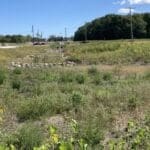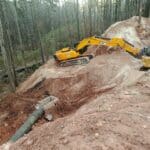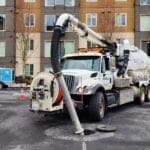City of Cleveland
The City of Cleveland is located in the Lake Erie Drainage Basin which includes the Rocky River Watershed, Big Creek Watershed, Mill Creek Watershed, Doan Brook Watershed, and Euclid Creek Watershed. Cleveland also includes Morgan Run Watershed, Dugway Brook Watershed, Shaw Brook Watershed, Nine Mile Creek Watershed, Green Creek Watershed, Kingsbury Run Watershed, and Walworth Run Watershed that are located in combined sewer areas. City of Cleveland is 75.6 square miles of which approximately 6.8 square miles drains into natural watercourses. The community is 91 % combined sewers and 9 % separate sewers.
Non-point stormwater runoff is rainwater and snowmelt that flows over solid, impervious surfaces such as streets, sidewalks and parking lots. Hard, compact soil also can prevent stormwater from infiltrating the ground, which can lead to street flooding and erosion. Runoff can carry debris, chemicals, sediment or other pollutants on the ground into sewer catch basins and can flow into local waterways untreated. This can cause contamination of our drinking water and compromise recreation areas along Lake Erie, which is Northeast Ohio’s main source of drinking water.
The City adopted an improved stormwater management regulation that addresses both stormwater quality and quantity and encourages the use of non-structural stormwater management techniques. Cleveland Codified Ordinances Chapter 3116 also encourages the use of low impact development practices on our commercial and institutional areas. In addition, the City is in the process of amending its Zoning regulations that govern riparian and wetland areas.
Structural BMPs created through the improved stormwater management regulation will be maintained by post-development landowners. If landowners do not complete necessary operation and maintenance, the City of Cleveland will reserve the right to make the correction or issue citations pursuant to the Codified Ordinances of the City of Cleveland Section 3103. Long-term maintenance will be handled by the Department of Building and Housing Department, who is also responsible for the enforcement of the Post-Construction Stormwater Management Plan.
City of Cleveland Municipal Code
CHAPTER 3116 – CONSTRUCTION AND POST-CONSTRUCTION SITE STORM WATER RUNOFF CONTROL
§ 3116.02 General Provisions
- Lands to Which This Chapter Applies. This chapter shall apply to all areas of the City of Cleveland.
- Discharges to Which This Chapter Applies. This chapter shall apply to all new and existing discharges composed of storm water associated with construction activity that enters surface waters of the State, or a storm drain leading to surface waters of the State, or to a public sewer drain. Discharges of materials not composed entirely of storm water, including but not limited to materials containing discarded building materials, concrete truck washout, chemicals, litter, or sanitary waste, must comply with all other applicable laws and regulations.
- Conflict with Other Regulations. This chapter is intended to be supplemental to any city regulation, or policy governing the development of land, the removal of soil, other land-disturbing activity. The most restrictive standards imposed by any city ordinance, regulation, or policy shall apply.
(Ord. No. 807-09. Passed 7-1-09, eff. 7-8-09)
§ 3116.03 Permit Required
- It shall be unlawful for any person to undertake any construction activity without first obtaining a permit from the Director.
- It shall be unlawful for any permittee to fail to comply with their permit.
(Ord. No. 807-09. Passed 7-1-09, eff. 7-8-09)
§ 3116.04 Plan Review, Inspections and Record Keeping; Contract Authority
The Director of Building and Housing is authorized to enter into contracts for professional services necessary to provide training, and to assist with plan review, inspections, and record-keeping, as needed to administer this chapter.
The compensation to be paid for such services shall be fixed by the Board of Control. Professional services contracts authorized by this section shall be prepared by the Director of Law, approved by the Director of Building and Housing, certified by the Director of Finance, and paid from the annual appropriations made for such purpose.
(Ord. No. 807-09. Passed 7-1-09, eff. 7-8-09)
§ 3116.05 Permit Application; Fee
- The Director may charge a permit application fee as established from time to time by the Board of Control.
- Any person desiring a permit required by this chapter shall file an application with the Director. The application shall consist of:
- The permit application fee;
- Two (2) or more copies of a Storm Water Pollution Prevention Plan (SWP3)
- A long-term inspection and maintenance covenant that provides the City with a right of inspection and appropriate indemnification, and meets the inspection requirements described in Section 3116.08 and runs with the land, is binding upon the owner, the owner’s successors and assigns, and all subsequent owners of the property, and is recorded by the applicant with the Cuyahoga County Recorder’s Office. The applicant must provide the City with a recorded copy prior to the final inspection and approval.
(Ord. No. 861-2022. Passed 10-24-22, eff. 10-31-22)
§ 3116.06 Approval or Disapproval of Storm Water Pollution Prevention Plan
- The Director shall review storm water pollution prevention plans submitted to him or her and grant written approval if he or she determines that the plan meets the requirements prescribed in Ohio EPA Permit No. OHC000005 April 23, 2018 and any subsequent versions of that permit issued by the Ohio EPA and this chapter.
- When a plan is determined to be inadequate, written notice of disapproval stating the specific reasons for disapproval shall be communicated to the applicant. The notice shall specify the modifications, terms and conditions that are necessary for approval of the plan.
(Ord. No. 861-2022. Passed 10-24-22, eff. 10-31-22)
§ 3116.07 Issuance of Permit; Appeal
- The Director shall issue a permit approving construction activity under this chapter on approval of the SWP3, the post-construction and operation maintenance plan, and a recorded long-term inspection and maintenance covenant.
- Any denial of a permit under the provisions of this chapter may be appealed to the Board of Building Standards and Building Appeals as provided in the Charter and in Section 3103.20.
(Ord. No. 861-2022. Passed 10-24-22, eff. 10-31-22)
§ 3116.08 Periodic Inspections of Construction Activities
- The Director may make periodic inspections of construction activities or land-disturbing activities to ensure compliance with this chapter. The right of inspection shall be inherent in the issuance of the permit under this chapter.
- All applicable permits and approved SWP3s under this chapter shall be made immediately available on site upon request of the Director or his or her authorized representative during working hours.
-
The owner shall inspect all the storm water control BMPs and measures, at a minimum under the frequency required under Ohio EPA Permit No. OHC000005 effective April 23, 2018 and any subsequent versions of that permit issued by the Ohio EPA, and every six months and after major storm events for the first year of operation, and at least once every year thereafter to ensure the storm water measures are functioning properly.
(Ord. No. 861-2022. Passed 10-24-22, eff. 10-31-22)
§ 3116.09 Amendment of Approved Plan
A SWP3 approved under this chapter may be amended by the Director in the following cases:
- Where inspection reveals that the plan is inadequate to satisfy applicable regulatory provisions; or
- Where the person responsible for carrying out the approved plan finds that because of changed circumstances or for other reasons the approved plan cannot be effectively carried out, and the person proposes amendments to the plan consistent with the requirements of this chapter.
(Ord. No. 807-09. Passed 7-1-09, eff. 7-8-09)
§ 3116.10 Final Inspection, Certificate of Completion of Construction Activities and Post Construction Management
- Persons obtaining a permit under this chapter must continue to meet the applicable requirements of Ohio EPA Permit No. OHC000005 and this chapter until they receive, upon written request, a certificate of completion issued by the Director. A certificate of completion may be issued on finding satisfactory evidence of compliance with the approved SWP3 and the achievement of adequate stabilization. “Adequate stabilization” of the site shall be determined by the Director.
- The permittee, or any person identified in an approved SWP3 as responsible for the inspection and maintenance of construction storm water best management practices shall be responsible for inspecting and maintaining them until the receipt of a certificate of completion.
- The owner, the owner’s successors and assigns, and all subsequent owners of the property identified in an approved SWP3 and long-term inspection and maintenance covenant, who are responsible for the continuing obligations for the inspection and maintenance of post-construction best management practices, shall be responsible for the inspection and maintenance of post-construction best management practices and shall not be relieved of those continuing obligations once coverage under a permit is terminated or by the issuance of a certificate of completion.
-
The permittee must provide copies of all post-construction operation and management plans as a stand-alone document, the approved SWP3, and the long-term inspection and maintenance covenant, to the post-construction operator of the site (including homeowner associations) and land owners, upon completion of construction activities prior to termination of permit coverage.
-
The post-construction operator of the site and the owner of the premises subject to the provisions of this Building Code shall continue to be responsible for maintenance and compliance with the post-construction storm water best management practices (“BMPs”) described in the approved SWP3 and as required by the long-term inspection and maintenance covenant.
- A violation of a provision in this section requiring compliance with a post-construction BMPs is a violation of this chapter.
(Ord. No. 861-2022. Passed 10-24-22, eff. 10-31-22)
§ 3116.11 Periodic and Final Inspection Fees
The Director is authorized to charge fees for periodic or final inspections according to an inspection fee schedule fixed from time to time by the Board of Control.
(Ord. No. 807-09. Passed 7-1-09, eff. 7-8-09)
§ 3116.13 Severability
If any portion of this chapter, or any section or part of a section shall be declared by a court of competent jurisdiction to be invalid, the declaration shall be limited solely to that portion, section, or part of a section that was directly involved in the controversy before the court on which judgment was rendered and shall not affect or impair the validity of the remainder of the chapter.
(Ord. No. 807-09. Passed 7-1-09, eff. 7-8-09)
MEMORANDUM OF UNDERSTANDING
Between the THE DOAN BROOK WATERSHED PARTNERSHIP And the CITY OF CLEVELAND
Recognizing the need for effective collaboration in carrying out mandated responsibilities, especially related to the National Pollutant Discharge Elimination System (NPDES) Stormwater Phase II permit, the City of Cleveland (City) and the Doan Brook Watershed Partnership (DBWP) accept this agreement as the document which describes the process for exchange. Cooperation between these two units facilitates solutions to problems encountered by the city as it plans for the development/redevelopment and conservation of its environment, as well as, water quality improvements. In making technical assistance and expertise available to the City, the DBWP hopes to influence local planning and regulatory capability toward better conservation of water resources.
For ease of understanding, this agreement is arranged according to the order of the Six Minimum Controls for NPDES Phase II for stormwater as defined with the Ohio Revised Code 3745-39-04 (B)(l) through (6).
Links
Cleveland Code of Ordinances
City of Cleveland Stormwater Management Report
 Kenosha, Wis. Highway KR Regenerative Stormwater ConveyanceThe Root-Pike Watershed Initiative Network Kenosha County, and others worked with AQUALIS to design and implement an innovative solution for stormwater control along Highway KR.
Kenosha, Wis. Highway KR Regenerative Stormwater ConveyanceThe Root-Pike Watershed Initiative Network Kenosha County, and others worked with AQUALIS to design and implement an innovative solution for stormwater control along Highway KR. Durham, N.C. Sinkhole Leads to Stormwater System RehabilitationThe tenant on this property noticed a depression that opened to the ground below and notified the property owners.
Durham, N.C. Sinkhole Leads to Stormwater System RehabilitationThe tenant on this property noticed a depression that opened to the ground below and notified the property owners.
